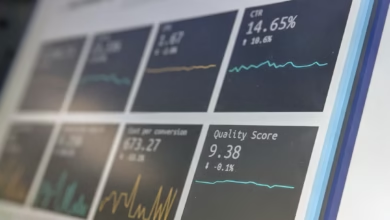Mastering CFD Trading: Strategies and Risk Management for Speculating on Price Movements Without Ownership

In the dynamic world of online trading, Contract for Difference (CFD) trading has emerged as a popular choice for traders looking to speculate on price movements without the need to own the underlying asset. This innovative trading method allows individuals to engage in various markets, including stock trading, forex trading, and commodities trading, offering a unique opportunity to capitalize on both rising and falling prices. As a derivative trading instrument, CFDs provide access to a wide array of assets such as indices, cryptocurrencies, and ETFs, making it a versatile option for traders of all levels.
Understanding the nuances of CFD trading is crucial for success, especially in a landscape filled with diverse trading strategies like swing trading, scalping, and day trading. However, with the potential for significant rewards comes the inherent risks associated with leverage trading and margin trading. Effective risk management and a solid grasp of market analysis—both technical analysis and fundamental analysis—are essential for navigating this complex terrain.
In this comprehensive guide, we will explore the fundamentals of CFD trading, delve into key trading strategies for maximizing profits, and discuss effective risk management techniques to help traders balance their ambitions with prudent practices. Whether you're a novice trader or looking to refine your skills in high-frequency trading or algorithmic trading, this article will equip you with the knowledge needed to thrive in the competitive world of CFD trading.
- 1. Understanding CFD Trading: A Comprehensive Guide to Speculating on Price Movements
- 2. Key Trading Strategies for Successful CFD Trading: From Swing Trading to Scalping
- 3. Risk Management in CFD Trading: Balancing Leverage and Margin Trading for Optimal Returns
1. Understanding CFD Trading: A Comprehensive Guide to Speculating on Price Movements
CFD trading, or Contract for Difference trading, has emerged as a popular method for speculating on price movements across various financial markets without the necessity of owning the underlying asset. This innovative trading approach allows traders to engage in stock trading, forex trading, commodities trading, and even crypto trading, among others, by entering into a contract that reflects the price changes of the assets.
One of the primary advantages of CFD trading is the ability to leverage trading, which enables traders to control larger positions with a smaller amount of capital through margin trading. This can amplify potential profits, but it also increases the risk, making risk management a crucial aspect of a successful trading strategy. Traders must employ effective risk management techniques to safeguard their investments, especially in volatile markets.
In CFD trading, market analysis plays a vital role. Traders often utilize both technical analysis and fundamental analysis to make informed decisions. Technical analysis involves studying price charts and patterns, while fundamental analysis assesses the underlying factors influencing asset prices, such as economic indicators and news events. Combining these analyses can provide a comprehensive view of market trends, which is essential for developing effective trading strategies.
Moreover, trading psychology is an important aspect that can significantly influence trading outcomes. Understanding one’s emotional responses to market fluctuations can help traders maintain discipline and avoid impulsive decisions, which is particularly beneficial in high-stakes environments like day trading and swing trading.
CFD trading caters to various trading styles, including scalping, which involves making quick trades to profit from small price movements, and algorithmic trading, where automated systems execute trades based on predefined criteria. Additionally, copy trading and social trading allow less experienced traders to mimic the strategies of successful traders, providing a unique opportunity for learning and growth.
Furthermore, CFD trading encompasses a wide range of markets, including index trading and energy trading, making it a versatile option for traders seeking diversification. However, it's crucial to choose reliable online trading platforms that offer robust features and resources to enhance the trading experience.
In conclusion, CFD trading presents a dynamic and flexible approach to speculating on price movements across various asset classes. By understanding the intricacies of this trading method and applying sound trading strategies, traders can navigate the complexities of the market while maximizing their potential for success.
2. Key Trading Strategies for Successful CFD Trading: From Swing Trading to Scalping
CFD trading offers a dynamic way to speculate on price movements across a variety of markets, including stock trading, forex trading, and commodities trading, without the need to own the underlying assets. To maximize success in this arena, traders often employ specific strategies tailored to their trading style and market conditions. Here are two key trading strategies that can significantly enhance your CFD trading experience: swing trading and scalping.
Swing trading is a popular approach that involves holding positions for several days or weeks, aiming to profit from short- to medium-term price fluctuations. This strategy relies heavily on technical analysis to identify potential entry and exit points based on chart patterns and market trends. Swing traders often use tools like moving averages and Fibonacci retracements to make informed decisions, while also incorporating fundamental analysis to understand broader market movements. This method allows traders to capitalize on price swings while managing risk effectively, making it a great fit for those who prefer a less intense trading pace compared to day trading or high-frequency trading.
On the other hand, scalping is a high-energy strategy that focuses on making numerous small trades throughout the day. Scalpers aim to exploit minute price changes, often holding positions for just a few seconds or minutes. This strategy requires quick decision-making and a strong grasp of trading psychology, as emotions can run high during rapid trades. Scalpers typically use algorithmic trading systems to execute trades at lightning speed, enabling them to capitalize on small price differentials. With leveraged positions often utilized in margin trading, scalpers must maintain rigorous risk management practices to protect their capital against rapid market fluctuations.
Both swing trading and scalping come with their unique sets of advantages and challenges. Whether you prefer a longer-term approach to position trading or the fast-paced environment of scalping, understanding these strategies will enhance your overall trading effectiveness. By incorporating sound market analysis and risk management techniques, traders can navigate the complexities of CFD trading more confidently, regardless of the chosen strategy.
Ultimately, successful CFD trading hinges on your ability to adapt your trading strategies to various market conditions while maintaining discipline and focus.
3. Risk Management in CFD Trading: Balancing Leverage and Margin Trading for Optimal Returns
In CFD trading, effective risk management plays a crucial role in achieving optimal returns while minimizing potential losses. The combination of leverage and margin trading can amplify profits, but it can also lead to significant risks if not managed properly.
One of the key aspects of risk management in CFD trading is understanding leverage. Leverage allows traders to control a larger position with a smaller amount of capital, which can enhance returns. However, it also increases exposure to market fluctuations. For example, in forex trading, a trader might use leverage of 1:100, meaning that for every dollar in their account, they can trade $100. While this can lead to substantial gains, a small adverse price movement can result in considerable losses.
Margin trading is closely related to leverage and involves the use of borrowed funds to increase the potential return on investment. Traders must maintain a certain margin level, which acts as collateral for the borrowed capital. If the market moves against a trader's position, they may face a margin call, requiring them to deposit additional funds or close positions to mitigate losses. This highlights the importance of monitoring margin levels and having a clear exit strategy.
To successfully navigate the complexities of CFD trading, traders should employ various trading strategies tailored to their risk tolerance. For instance, day trading and swing trading involve shorter holding periods and may require more active management and technical analysis to identify entry and exit points. On the other hand, longer-term strategies, such as position trading or algorithmic trading, may allow for more relaxed risk management protocols.
Moreover, integrating fundamental analysis and trading psychology into risk management can help traders make informed decisions. Understanding market trends and economic indicators can provide insights into potential price movements, while maintaining a disciplined mindset can prevent emotional trading decisions.
Ultimately, balancing leverage and margin trading through sound risk management practices is essential for success in CFD trading. By implementing effective risk management strategies, such as setting stop-loss orders and diversifying across different asset classes like commodities trading, index trading, and crypto trading, traders can safeguard their investments while pursuing their trading goals.
In summary, successful CFD trading hinges on a thorough understanding of risk management principles, allowing traders to optimize their returns while safeguarding against the inherent risks associated with leverage and margin trading.
In conclusion, CFD trading presents a dynamic avenue for speculating on price movements across various markets, including stock trading, forex trading, and commodities trading. As we've explored, understanding the fundamentals of CFD trading is essential for any trader looking to capitalize on price fluctuations without the need to own the underlying asset. By employing key trading strategies such as swing trading and scalping, traders can enhance their chances of success while adapting to market conditions.
However, with the potential for high rewards comes significant risks. Effective risk management is crucial in CFD trading, especially when leveraging margin trading strategies. Balancing leverage with a keen awareness of trading psychology can help mitigate losses and optimize returns. It's important to utilize both technical and fundamental analysis to inform your trading decisions, ensuring a well-rounded approach to market analysis.
As you embark on your CFD trading journey, consider exploring online trading platforms that offer tools for copy trading, social trading, and algorithmic trading to further enhance your trading strategies. With a solid understanding of the intricacies of derivatives trading, including the distinctions between binary options and futures trading, you'll be equipped to navigate the complexities of this market. Whether you’re interested in day trading, crypto trading, or energy trading, remember that continuous learning and adaptation are key to thriving in the ever-evolving trading landscape.
References:
[Insert relevant sources here]




